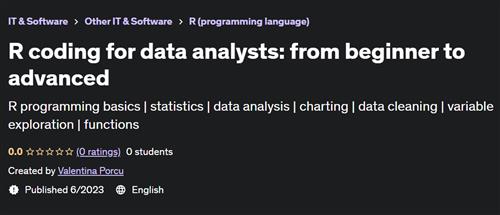 Free Download R coding for data analysts from beginner to advanced
Free Download R coding for data analysts from beginner to advancedPublished 6/2023
Created by Valentina Porcu
MP4 | Video: h264, 1280x720 | Audio: AAC, 44.1 KHz, 2 Ch
Genre: eLearning | Language: English | Duration: 82 Lectures ( 10h 14m ) | Size: 4 GB
R programming basics | statistics | data analysis | charting | data cleaning | variable exploration | functions
What you'll learn
Learn the fundamentals of programming with R
Set your working session
Explore the core tools for R coding
Create objects and functions in R
Create and recognize vectors, lists, arrays, dataframes and all the data structures in R
Convert objects
Using the logical operators
When and how to use the conditional statements
Explore your datasets
Installing and retrieving packages for extending the functionality of R
Generating random sequences on R
Extracting elements from an object or dataset
Manipulating vectors, matrices, datasets
Handling missing values and duplicates
Manipulating Dates
Import files in various formats, .csv, Excel, .txt and others
Manipulating datasets, reorganising and aggregating them
Restructuring and aggregating data
Creating graphs with basic functions and common packages
Creating and exporting reports in various formats
Understanding the basics of statistics with R
Requirements
Your computer, an internet connection
R and RStudio, but we will install them also together
Description
This basic programming course with R for aspiring data analysts is designed to accompany a beginner in programming, from the basics of the programming language (one of the best known and most widely used in the field of data analysis) to the use of descriptive statistics.At the end of this course the student will be able to create, import, manipulate and manage datasets. The course starts with setting up the working environment: we will see how to download, install and use some of the most important tools for using R, such as RStudio. We will then move on to the creation of objects: R is based on certain structures that we need to know, such as vectors, matrices, lists and dataframes. Once we understand how to create and manipulate these data structures, extract elements from them and save them locally on the computer, we will move on to the use of loops and the creation of functions. In the next section, we will look at a number of useful topics: how to set up a working directory, how to install and retrieve a package, how to get information about data, where to find datasets for testing, and how to get help with a function.When analysing data, one sooner or later comes across dataframes known as variable x-cases. We will therefore see how to import a dataframe from your computer, or from the internet, into R. There are many functions that are suitable for this purpose, and many packages that are useful for importing data that is in some particular format, such as the formats for Excel, .csv, .txt or JSON.We will then see how to manipulate data, create new variables, aggregate data, sort them horizontally and longitudinally, and merge two datasets. To do this, we will use some specific packages and functions, such as dplyr, tidyr or reshape2. We will also briefly see how to interface with a database and use other packages to streamline the management of somewhat larger datasets. R is also a very important language in the field of statistics. We will therefore learn some of the basic functions, such as calculating averages per row or per column, and the most common statistical functions in the field of descriptive statistics, such as mean, median, fashion, standard deviation, displaying the distribution and more.When it comes to data analysis, we will often find ourselves creating graphs to explain our data and analyses. For this reason, we devote a section of the course to seeing how to create graphs with both the functions of the basic library and the ggplot2 package. In the last lessons of the course, we will see how to create and export reports and slides, summarise the topics we have seen and the functions we have used, and see the supporting material.All sections of the course are accompanied by coding exercises and videos and scripts with solutions. You can test your knowledge with quiz and practical test with increasing levels of difficulty.
Who this course is for
Beginners to programming
Data Scientist in other programming languages (e.g. Python)
People interested in data analysis and data science
Homepage
https://www.udemy.com/course/r-coding-for-data-analysts-from-beginner-to-advanced/
Buy Premium From My Links To Get Resumable Support,Max Speed & Support Me
Links are Interchangeable - Single Extraction
Comments

